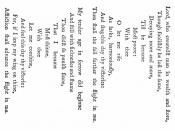"The Flower" by George Herbert is an exuberant, joyful poem in which a single image of the spiritual life is expanded with naturalness and elegance that appear effortless. Herbert refines a style in which the writer tries to write honestly and directly from experience: his imagery is more homely and accessible than John Donne's: if nothing is too exotic for inclusion in Donne's verse, nothing is too ordinary for inclusion in Herbert's. But this has the result that Herbert's images are, generally, more intelligible to the modern reader.
In The Flower, Herbert celebrates the joy that accompanies the spiritual renewal, which follows the times of trial. Though he has experienced this many times, yet each time it happens the joy is as boundless as ever. In the second line of the poem he likens this to the regeneration of "the flowers in spring"(2) and thereafter writes of himself as if he were such a flower.
This clear statement of the simile makes it plain to the reader that everything written about the flower is to be understood as a picture of man's life in relation to God. Yet we can also delight in the idea of the flower's expressing its feelings about the killing frosts which the "tributes of pleasure bring"(4). The flower, loving the return of spring, but fearful of a late frost, and certain that winter will eventually come again, longs for the perpetual spring of "...Paradise where no flower can wither"(23). By its selfishness and sinfulness it is watered and tries to seize heaven by its own growth; such arrogance must then be punished by God's anger, more severe than any frost. Yet God's severity is remedial not malicious, when the lesson is learned, the flower may be allowed to put out new growth. This is...


